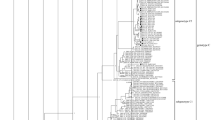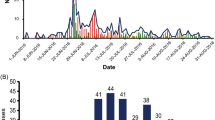Abstract
We determined four complete nucleotide sequences of echovirus 6 (E6) isolated from an epidemic of aseptic meningitis (AM) in Hokkaido, Japan, in 2011. Phylogenetic analysis of the genes encoding viral capsid protein 1 revealed that the strains were closely related to E6 strains isolated in China in recent years, but they were distantly related to E6 strains isolated from patients with AM in Osaka Prefecture, Japan, in 2011. The genes encoding the viral protease and RNA-dependent RNA polymerase (3CD) were closely related to those of several non-E6 strains of the species Human enterovirus B isolated in China, South Korea, and Australia from 1999 to 2010, resulting in a novel cluster in the phylogenetic tree. These results suggest that the incidence of AM in Japan in 2011 was caused by at least two lineages of E6 strains, and a lineage of the 3CD gene was interspersed among different serotypic strains isolated in Western Pacific countries.



Similar content being viewed by others
References
Bailly JL, Mirand A, Henquell C, Archimbaud C, Chambon M, Regagnon C, Charbonné F, Peigue-Lafeuille H (2010) Repeated genomic transfers from echovirus 30 to echovirus 6 lineages indicate co-divergence between co-circulating populations of the two human enterovirus serotypes. Infect Genet Evol 11:276–289
Bedard KM, Semler BL (2004) Regulation of picornavirus gene expression. Microbes Infect 6:702–713
Cui A, Yu D, Zhu Z, Meng L, Li H, Liu J, Liu G, Mao N, Xu W (2010) An outbreak of aseptic meningitis caused by coxsackievirus A9 in Gansu, the People’s Republic of China. Virol J 7:72–80
Domingo E, Holland JJ (1997) RNA virus mutations and fitness for survival. Annu Rev Microbiol 51:151–178
Drake JW (1993) Rates of spontaneous mutation among RNA viruses. Proc Natl Acad Sci USA 90:4171–4175
Felsenstein J (1985) Confidence limits on phylogenies: an approach using the bootstrap. Evolution 39:783–791
Han JF, Jiang T, Fan XL, Yang LM, Yu M, Cao RY, Wang JZ, Qin ED, Qin CF (2012) Recombination of human coxsackievirus b5 in hand, foot, and mouth disease patients, China. Emerg Infect Dis 18:351–353
Hyypiä T, Hovi T, Knowles NJ, Stanway G (1997) Classification of enteroviruses based on molecular and biological properties. J Gen Virol 78:1–11
Ishiko H, Shimada Y, Yonaha M, Hashimoto O, Hayashi A, Sakae K, Takeda N (2002) Molecular diagnosis of human enteroviruses by phylogeny-based classification by use of the VP4 sequence. J Infect Dis 185:744–754
Jung EH, Park KS, Baek KA, Kim DU, Kang SY, Kang BH, Cheon DS (2010) Genetic diversity of echovirus 6 strains circulating in Korea. J Bacteriol Virol 40:191–198
Khetsuriani N, Lamonte-Fowlkes A, Oberste S, Pallansch MA (2006) Enterovirus surveillance—United States, 1970-2005. MMWR Surveill Summ 55(SS08):1–20
Lole KS, Bollinger RC, Paranjape RS, Gadkari D, Kulkarni SS, Novak NG, Ingersoll R, Sheppard HW, Ray SC (1999) Full-length human immunodeficiency virus type 1 genomes from subtype C-infected seroconverters in India, with evidence of intersubtype recombination. J Virol 73:152–160
Lukashev AN, Lashkevich VA, Ivanova OE, Koroleva GA, Hinkkanen AE, Ilonen J (2005) Recombination in circulating Human enterovirus B: independent evolution of structural and non-structural genome regions. J Gen Virol 86:3281–3290
Mao N, Zhao L, Zhu Z, Chen X, Zhou S, Zhang Y, Cui A, Ji Y, Xu S, WenBo X (2010) An aseptic meningitis outbreak caused by echovirus 6 in Anhui province, China. J Med Virol 82:441–445
Markey PG, Davis JS, Harnett GB, Williams SH, Speers DJ (2010) Meningitis and a febrile vomiting illness caused by echovirus type 4, Northern Territory, Australia. Emerg Infect Dis 16:63–68
McWilliam Leitch EC, Cabrerizo M, Cardosa J, Harvala H, Ivanova OE, Kroes AC, Lukashev A, Muir P, Odoom J, Roivainen M, Susi P, Trallero G, Evans DJ, Simmonds P (2010) Evolutionary dynamics and temporal/geographical correlates of recombination in the human enterovirus echovirus types 9, 11, and 30. J Virol 84:9292–9300
Miyoshi M, Yoshizumi S, Ishida S, Komagome R, Nagano H, Kudo S, Okano M (2012) Usefulness of the rapid determination system of viral genome sequences in human stool specimens. J Virol Methods 179:256–260
Mizutani T, Endoh D, Okamoto M, Shirato K, Shimizu H, Arita M, Fukushi S, Saijo M, Sakai K, Chang KL, Ito M, Nerome R, Takasaki T, Ishii K, Suzuki T, Kurane I, Morikawa S, Nishimura H (2007) Rapid genome sequencing of RNA viruses. Emerg Infect Dis 13:322–324
Norder H, Bjerregaard L, Magnius L, Lina B, Aymard M, Chomel JJ (2003) Sequencing of ‘untypable’ enteroviruses reveals two new types, EV-77 and EV-78, within human enterovirus type B and substitutions in the BC loop of the VP1 protein for known types. J Gen Virol 84:827–836
Oberste MS, Maher K, Kilpatrick DR, Pallansch MA (1999) Molecular evolution of the human enteroviruses: correlation of serotype with VP1 sequence and application to picornavirus classification. J Virol 73:1941–1948
Oberste MS, Maher K, Michele SM, Belliot G, Uddin M, Pallansch MA (2005) Enteroviruses 76, 89, 90 and 91 represent a novel group within the species Human enterovirus A. J Gen Virol 86:445–451
Oberste MS, Maher K, Nix WA, Michele SM, Uddin M, Schnurr D, al-Busaidy S, Akoua-Koffi C, Pallansch MA (2007) Molecular identification of 13 new enterovirus types, EV79-88, EV97, and EV 100-101, members of the species Human enterovirus B. Virus Res 128:34–42
Oberste MS, Maher K, Pallansch MA (2004) Evidence for frequent recombination within species Human enterovirus B based on complete genomic sequences of all thirty-seven serotypes. J Virol 78:855–867
Oberste MS, Michele SM, Maher K, Schnurr D, Cisterna D, Junttila N, Uddin M, Chomel JJ, Lau CS, Ridha W, al-Busaidy S, Norder H, Magnius LO, Pallansch MA (2004) Molecular identification and characterization of two proposed new enterovirus serotypes, EV74 and EV75. J Gen Virol 85:3205–3212
Oberste MS, Schnurr D, Maher K, al-Busaidy S, Pallansch MA (2001) Molecular identification of new picornaviruses and characterization of a proposed enterovirus 73 serotype. J Gen Virol 82:409–416
Pallansch M, Roos R (2007) Enteroviruses: polioviruses, coxsackieviruses, echoviruses, and newer enteroviruses. In: Knipe DM, Howley PM, Griffin DE, Lamb RA, Martin MA, Roizman B, Straus SE (eds) Fields virology, 5th edn. Lippincott, Williams & Wilkins, Philadelphia, pp 839–893
Racaniello VR (2007) Picornaviridae: the viruses and their replication. In: Knipe DM, Howley PM, Griffin DE, Lamb RA, Martin MA, Roizman B, Straus SE (eds) Fields virology, 5th edn. Lippincott, Williams & Wilkins, Philadelphia, pp 796–838
Rossman MG, Arnold A, Erickson JW, Frankenberger EA, Griffith JP, Hecht HJ, Johnson JE, Kamer G, Luo M, Mosser AG, Rueckert RR, Sherry B, Vriend G (1985) Structure of a human common cold virus and functional relationship to other picornaviruses. Nature 317:145–153
Saitou N, Nei M (1987) The neighbor-joining method: a new method for reconstructing phylogenetic trees. Mol Biol Evol 4:406–425
Santti J, Hyypiä T, Kinnunen L, Salminen M (1999) Evidence of recombination among enteroviruses. J Virol 73:8741–8749
Stanway G, Brown F, Christian P, Hovi T, Hyypiä T, King AMQ, Knowles NJ, Lemon SM, Minor PD, Pallansch MA, Palmenberg AC, Skern T (2005) Picornaviridae. In: Fauquet CM, Mayo MA, Maniloff J, Desselberger U, Ball LA (eds) Virus taxonomy VIII. Elsevier Academic Press, San Diego, pp 757–778
Tamura K, Nei M, Kumar S (2004) Prospects for inferring very large phylogenies by using the neighbor-joining method. Proc Natl Acad Sci USA 101:11030–11035
Tamura K, Peterson D, Peterson N, Stecher G, Nei M, Kumar S (2011) MEGA5: molecular evolutionary genetics analysis using maximum likelihood, evolutionary distance, and maximum parsimony methods. Mol Biol Evol 28:2731–2739
Tao Z, Cui N, Xu A, Wang H, Song L, Li Y, Liu G, Liu Y, Feng L (2010) Genomic characterization of an enterovirus 97 strain isolated in Shandong, China. Virus Genes 41:158–164
Tao Z, Wang H, Li Y, Xu A, Zhang Y, Song L, Yoshida H, Xu Q, Yang J, Zhand Y, Liu Y, Feng L, Xu W (2011) Cocirculation of two transmission lineages of echovirus 6 in Jinan, China, as revealed by environmental surveillance and sequence analysis. Appl Environ Microbiol 77:3786–3792
Vreugdenhil GR, Schloot NC, Hoorens A, Rongen C, Pipeleers DG, Melchers WJG, Roep BO, Galama JMD (2000) Acute onset of type I diabetes mellitus after severe echovirus 9 infection: putative pathogenic pathways. Clin Infect Dis 31:1025–1031
Yamashita T, Ito M, Tsuzuki H, Sakae K, Minagawa H (2010) Molecular identification of enteroviruses including two new types (EV-98 and EV-107) isolated from Japanese travellers from Asian countries. J Gen Virol 91:1063–1066
Zhao YN, Perlin DS, Park S, Jiang RJ, Chen L, Chen Y, Gardiner R, Jiang QW (2006) FDJS03 isolates causing an outbreak of aseptic meningitis in China that evolved from a distinct echovirus 30 lineage imported from countries of the Commonwealth of Independent States. J Clin Microbiol 44:4142–4148
Acknowledgments
The authors are grateful to the staff of the local hospital and of the regional Public Health Office, Naosuke Saji, Department of Health and Welfare, Hokkaido Government, for collecting samples and providing epidemiological information. This work was financially supported in part by the scientific grant from Hokkaido Government, Japan.
Author information
Authors and Affiliations
Corresponding author
Rights and permissions
About this article
Cite this article
Miyoshi, M., Komagome, R., Ishida, S. et al. Genomic characterization of echovirus 6 causing aseptic meningitis in Hokkaido, Japan: a novel cluster in the nonstructural protein coding region of human enterovirus B. Arch Virol 158, 775–784 (2013). https://doi.org/10.1007/s00705-012-1535-0
Received:
Accepted:
Published:
Issue Date:
DOI: https://doi.org/10.1007/s00705-012-1535-0




